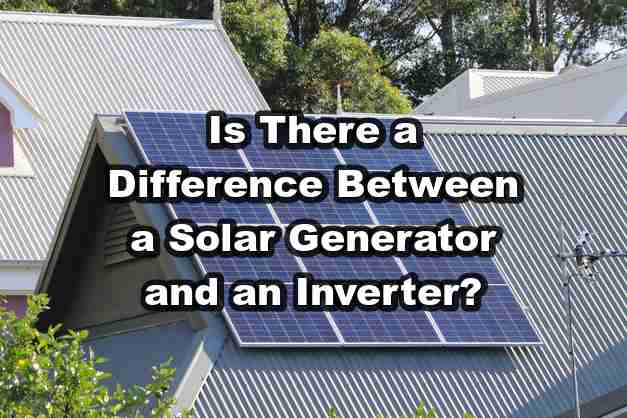Is there a difference between a solar generator and an inverter? Absolutely – they serve fundamentally different purposes in the renewable energy ecosystem.
A solar generator is a complete power station that integrates solar collection, battery storage, and power distribution into one portable package, while an inverter is a single specialized component that performs the critical function of converting DC electricity to AC power for your everyday devices.
This distinction matters whether you’re preparing for power outages, planning off-grid adventures, or seeking energy independence. Solar generators offer plug-and-play convenience with everything you need in one unit, eliminating technical complexity. Inverters, though essential, are just one piece of a larger system that requires additional components like batteries and charge controllers to function effectively.
By understanding these key differences, you’ll avoid costly purchasing mistakes and select the right solution that perfectly aligns with your power needs, budget constraints, and lifestyle requirements.
Key Takeaways
- Solar generators combine batteries, inverters, and charge controllers in one ready-to-use portable power system.
- Inverters perform the single critical function of converting DC electricity to AC power for household devices.
- Choose solar generators for portable applications like camping and emergency backup power without technical expertise.
- Consider standalone inverters when building larger, customized solar systems for permanent installations.
- Your specific power requirements, mobility needs, and technical comfort level should guide your final decision.
Basic Definitions
A solar generator is a complete power system that combines multiple components into a single unit. To understand its operation in detail, check out our guide on how a solar generator works. These systems include everything needed to collect, store, and distribute solar power.
An inverter, by contrast, is a single component that performs one specific function: converting direct current (DC) to alternating current (AC). While crucial for solar power systems, an inverter alone cannot generate or store power.
Core Components Comparison
A Solar generator integrates several essential components into one portable package. At its heart is a battery storage system that allows for power use when sunlight isn’t available. It also includes charge controllers to manage power flow and protect the battery and built-in inverters for power conversion. For a deeper look at solar technology, explore our solar generator category.
Inverters focus solely on power conversion, containing sophisticated circuitry that transforms DC power into usable AC power. Modern inverters often include features like:
- Pure sine wave output for sensitive electronics
- Advanced cooling systems
- Smart monitoring capabilities
- Multiple safety protections
Primary Functions and Applications
Solar generators serve as complete power solutions, capable of revolutionizing off-grid living. They collect solar energy through panels (such as Bluetti solar panels), store it in batteries, and provide power when needed. This makes them ideal for:
- Emergency backup power during outages
- Remote work sites requiring portable power
- Camping and outdoor activities
- Off-grid living situations
- Mobile power needs
Inverters, while essential, focus solely on power conversion. They excel in:
- Grid-tied solar installations
- Fixed battery backup systems
- RV electrical systems
- Marine power applications
- Industrial power conversion
Cost Considerations
The financial aspects of both technologies differ significantly. Solar generators typically require a higher initial investment but come as complete, ready-to-use systems. They require minimal installation and can be used immediately out of the box.
Inverters generally cost less individually but are just one component of a more extensive system. When considering an inverter, you must factor in additional components needed for a complete power solution:
- Solar panels
- Battery bank
- Charge controller
- Mounting hardware
- Installation costs
Making the Right Choice
Choosing between a solar generator and an inverter depends largely on your specific needs. Consider these factors:
Power Requirements: Solar generators work well for moderate power needs, while dedicated inverter systems can handle larger loads.
Portability: If you need mobile power, solar generators offer significant advantages with their all-in-one design.
Installation: Solar generators require minimal setup, while inverter systems typically need professional installation.
Budget: Consider both initial costs and long-term operational expenses when making your decision.
Conclusion
Understanding the fundamental difference between solar generators and inverters empowers you to make smarter energy investments tailored to your specific needs.
Solar generators deliver complete, portable power solutions with everything integrated into one user-friendly system—perfect for emergency preparedness, outdoor adventures, or small off-grid applications where simplicity and mobility matter most.
Inverters, while essential for any solar power system, represent just one piece of a larger energy puzzle. They excel at their specific task of converting DC to AC power but require additional components to create a functional system.
For permanent installations or larger power requirements, a custom system with separate components often provides better scalability, performance, and long-term value.
The right choice ultimately depends on your unique situation—your power demands, technical comfort level, and whether you prioritize portability or permanent installation.
Whichever path you choose, embracing solar technology puts clean, renewable energy directly in your hands, reducing your environmental footprint while ensuring reliable power exactly when and where you need it most.
For more detailed information about how solar generators function, visit our guide on how solar-powered generators work.








Leave a Reply